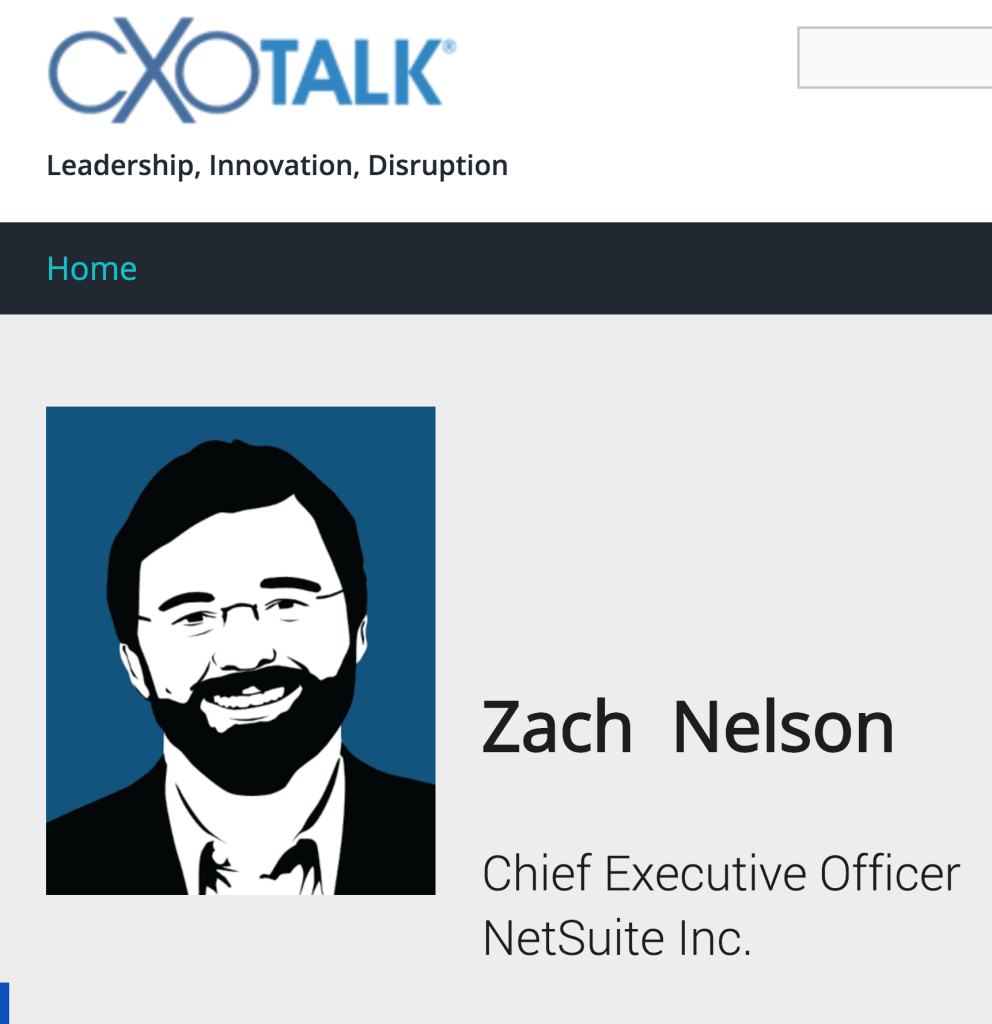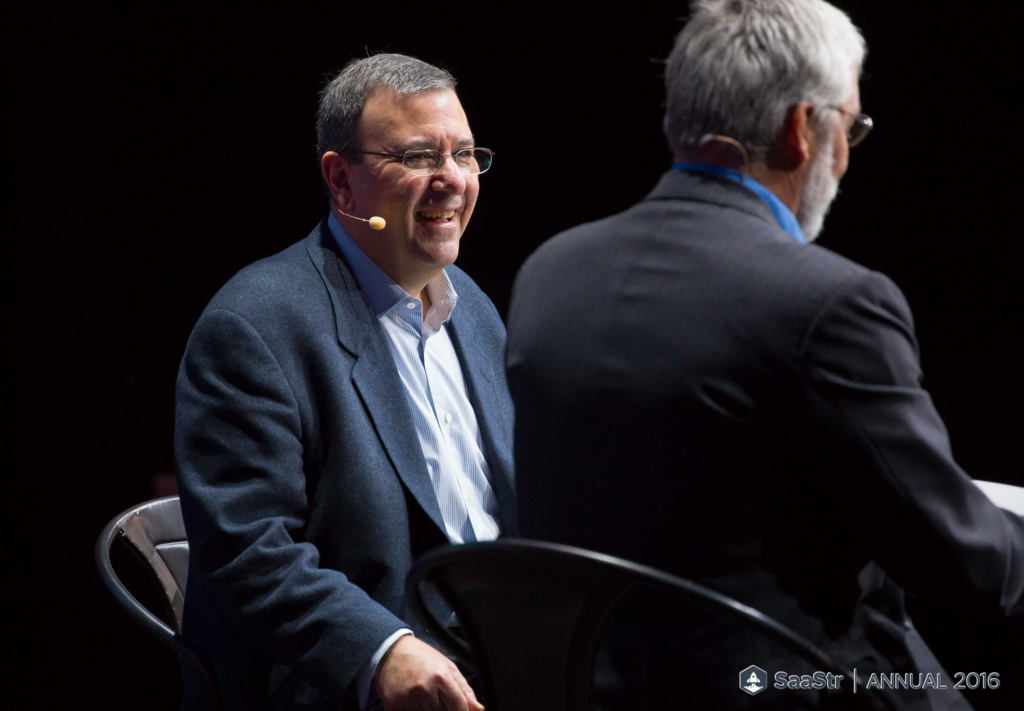Our good friend Michael Krigsman, who runs the excellent blog and interview platform CXO Talk, did me a huge favor at the ’16 Annual and interviewed Zach Nelson, CEO of NetSuite.
The interview and part of the transcript is below. I’m going to make you click over to Michael’s blog for the full transcript but the full video and part of the transcript is below. 🙂
It’s a good watch and read. Zach has been doing SaaS for as long as anyone, and has one of the most long-term views of customers and markets in the industry. ERP takes time to sell, deploy and manage and probably in part because of that, Zach has some of the most “professorial” and extended views of how you scale SaaS businesses of anyone.
This special episode of CXOTalk is being broadcast live from the SaaStr Annual 2016 conference stage.
 Zach Nelson, CEO of NetSuite, has led the company from small size to becoming a public company with almost $1 billion in revenue. In this episode, he describes SaaS company growth and the challenges along the way.
Zach Nelson, CEO of NetSuite, has led the company from small size to becoming a public company with almost $1 billion in revenue. In this episode, he describes SaaS company growth and the challenges along the way.
Mr. Nelson has led NetSuite to be one of the leading software-as-a-service companies in the world, where, under his leadership revenues have grown ten-fold, the workforce has quintupled to more than 500 employees and its customer base has expanded to thousands of companies. He has been a Director of NetSuite Inc since July 2002. From 1992 to 1996, he held various positions, including Vice President of Worldwide Marketing at Oracle Corporation. He was employed by McAfee Inc. (a/k/a Network Associates, Inc.) (now a part of Intel Corporation) from March 1996 to October 2001. Mr. Nelson joined Networks Associates Inc in March 1997 as the Vice President and General Manager of Network Management. From December 1999 to April 2001, Mr. Nelson served as the Chief Executive Officer and President of myCIO.com. Since April 2001, he served as the Chief Strategy Officer of myCIO.com.
Video Transcript: Growing a SaaS business, with Zach Nelson, CEO, NetSuite
Michael Krigsman:
(00:10) CXOTalk live. I’m Michael Krigsman and I am the founder of CXOTalk dot com. CXOTalk brings together the most innovative people on the planet for in depth conversations, and today we are honored to speak with Zach Nelson who is the CEO of NetSuite. Zach how are you?
Zach Nelson:
(00:34) Great to be here, this sort of reminds me of the founding of NetSuite. We were founded above a liquor store so we haven’t gone very far.
Michael Krigsman:
(00:42) So you’re returning to your roots. You know and I should say this, this is episode number 155 of CXOTalk. So Zach, tell us about NetSuite, what is NetSuite, what do you sell, who’s your market?
Zach Nelson:
(00:55) Well I’m sure many of you know NetSuite maybe use NetSuite. The founding story is interesting and I think arguably we were the first cloud business application company. Founded back in 1998, so it was a long time ago now. But our founder Evan Goldberg, still our Chairman, still our CTO that had founded a company that competed with the technology that became Flash. Macromedia bought Flash, his company went out of business and so he and Larry Ellison sat down to talk about what Evan wanted to do next.
(01:25) Evan was an incredible developer from Oracle and Larry had funded the first company. Even said, you know it’s really hard to run a small business. I have all these systems and in particular I have a problem with managing my salesforce, so I think I want to go and build a version of Seibel but make it more for small and mid-sized businesses. And Larry said, well that’s a great idea, but the problem with Seibel is there’s no customer data in Siebel. All the customer data is in the back office, what they bought, how they paid, was it shipped to them etcetera. So he said build the back office first and then build the suite and applications around it.
(01:57) The second thing he said was, and by the way deliver it over the internet because that’s how all software’s going to be delivered. And the last thing he said, which was a five minute conversation was, and make sure it has a web store on it because people are going to want to buy things on this internet. And really that’s the architecture of NetSuite today, and as an aside there was one other guy involved in that conversation named Marc Benioff and He went off. And two weeks later called back and said I’m going to do that Seibel online thing and that became Salesforce dot com, so both of the leaders today were founded literally in the same conversation with Larry Ellison.
Michael Krigsman:
(02:28) So this was 1997/8
Zach Nelson:
(02:33) Yeah and it was amazing in 1998 nobody believed complex applications would be delivered over the internet.
Michael Krigsman:
(02:40) And that internet thing you know and SaaS were toys.
Zach Nelson:
(02:43) That’s right. If you think about it, and if you think about the EBay’s and the Amazon’s of the world were the first generation software to service applications if you will, they weren’t toys. They’re the world’s largest businesses today, so it was pretty obvious that – at least in my mind, that everything was going to move to the internet.
Michael Krigsman:
(03:00) Okay, so today NetSuite is heading up on $1 billion in revenue, but you joined the company in 2002 when the company had less than $1 million in revenue and you went public in 2007. So take us through the stages of the development of NetSuite.
Zach Nelson:
(03:24) You know I joined NetSuite and my last job was at MacAfee and actually my last job at MacAfee 1999/2000 were taking our security products and putting them onto the internet. So we actually had a start up called MacAfee dot com, which ultimately went public which was a B2C version of the anti-virus delivered over the internet. And I ran a division called mycio dot com which was a B2B version of MacAfee dot com, and from that experience I realized really quickly that all software was going to be delivered this way, so I left MacAfee and began looking for companies doing business software on the internet.
(03:55) There were two at the time, one was called Salesforce, then at the time Net Ledger. One had a CEO; one didn’t have a CEO, so hence here I am today. But as you look at the sort of stages that we’ve gone through are sort of big categories. You know from 2002 to the IPO timeframe it was really about defining the metrics that defined our business, and within those metrics figuring out where the levers were that we could pull to accelerate the business.
(04:21) So on the sales side, how many deals could a rep do in a month or a quarter and at what average sales price. So that was pretty simple math the top on . For us it turned out they could do one or two deals a month, so how did you grow your business? You added sales reps in our case, so that was a huge driver of our business.
(04:38) The second element on the go to market side on the services front, unlike simple SaaS applications these were critical applications. Even though we were selling to small businesses at the time, so services became very important and the big challenge there was how do you do a big SAP like implementation and with many many zeroes missing off the purchase order, and so there were product things you did as well as repeatability things that you did.
(05:01) On the product side you know that’s evolved over time but those of you who are in SaaS startup companies, you know Evan and the team used to push software live. One Christmas Eve, Evan likes to talk about someone’s webstore had a problem and he went on, five minutes fixed it and pushed it during the middle of transactions. Well of course you don’t do that anymore, but you know, lots of releases to sort of very structured release processes as customers get more and more effective.
(05:28) So defining your metrics, driving them, and as you change the business measuring the old metrics compared to the new metrics is very important. So having a good view on – not losing your historical metrics is super important. The second sort of stage is really post-IPO, and when you go public you want to make sure actually that you have enough control over the business, that you’re not going to miss your numbers coming out of the gate, in fact grow the numbers. So I think it’s really mostly about executing in a big way at that time. And probably one of the most important parts of execution is retaining your people. You know you build these great organization you go public then you don’t want those people to walk out the door and be picked off by somebody else.
Michael Krigsman:
(06:06) So your initial set of metrics were all about deal size and how many deals we’re closing and how many salespeople do we have, and eventually you started looking at internal metrics in addition to the external facing metrics.
Zach Nelson:
Read the rest HERE on CXO Talk



